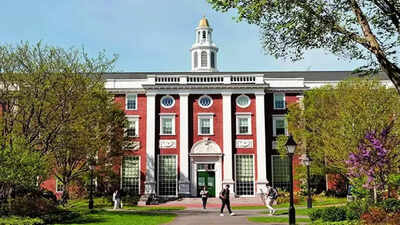
In a high-stakes battle shaking the pillars of American higher education, President Donald Trump and Harvard University are locked in a tense standoff over diversity, academic freedom, and the role of international students in U.S.
universities.Over the past few months, the Trump administration has escalated its campaign against Harvard, freezing approximately $2.3 billion in federal research funding. The move is a response to concerns about Harvard’s diversity policies and campus activism—issues the administration argues undermine merit-based admissions and disadvantage American students.On May 28, 2025, Trump proposed capping Harvard’s international student enrolment at 15%, a dramatic cut from its current 31%.
Trump backed his proposal by a simple reasoning: “to make Harvard great again.” The U.S. President criticised Harvard for its liberal stance and alleged antisemitic environment, suggesting that federal funds be redirected to trade schools. He emphasised that Harvard's substantial endowment, reportedly $52 billion, was significantly funded by the U.S.
government, questioning the institution's current direction and its impact on domestic students.
With over 6,800 international students currently enrolled at Harvard, the impact of such proposals could be huge. Students and faculty at Harvard have mobilised in protest, holding demonstrations and teach-ins to defend academic freedom, global diversity, and the critical role of international scholars in sustaining the U.S.'s status as a global innovation leader.The showdown highlights a deeper national debate over federal authority in higher education, institutional independence, and America’s place in the global knowledge economy.
With billions of dollars, thousands of students, and the future of U.S. higher education at stake, all eyes are on the courtroom—and the growing protests on the Harvard yard.
A diverse community at risk
Harvard’s strength lies in its ability to attract the best minds from across the world. International students fuel groundbreaking research, bring fresh perspectives into classrooms, and form vital connections across borders. From science and technology to the arts and public policy, their contributions are deeply embedded in Harvard’s academic ecosystem.A reduction in international students risks creating a more homogenised student body, with fewer opportunities for students to engage with differing perspectives. Collaborative group work, case studies, and policy simulations—staples of Harvard’s pedagogy—would all be less dynamic and globally relevant.
Domino effect on US innovation
Limiting international enrolment at Harvard may have far-reaching consequences. Reduced diversity could stifle the exchange of ideas that drives innovation, weaken global research partnerships, and diminish the university’s ability to tackle complex, international challenges.
Harvard’s global reputation, which draws top-tier faculty and research funding, could also be jeopardised.The presence of international students enriches classroom discussions, enhances peer-to-peer learning, and fosters a culture of academic curiosity informed by diverse worldviews. Capping international enrolment threatens to narrow this global lens, limiting the intellectual scope of the university experience.
Potential damage to research and innovation
Many of Harvard’s research programs rely heavily on international graduate students, postdoctoral fellows, and visiting scholars. These individuals contribute substantially to scientific progress in fields such as biotechnology, artificial intelligence, and public health. A cap on foreign students would shrink this pool of talent, potentially slowing the pace of innovation and weakening Harvard’s leadership in global research initiatives.International students often pay full tuition, making them a crucial source of revenue for the university. These funds help support financial aid for domestic students, research grants, faculty recruitment, and infrastructure. A forced reduction in international enrolment could tighten Harvard’s budget and create ripple effects that impact the broader university community—particularly lower-income students who rely on need-based aid.
An uncertain future for global education
Beyond Harvard, this policy risks sending a signal that the U.S. is retreating from its role as a leader in global education. Other countries with more welcoming policies toward international students may absorb the talent that would have once considered studying in the U.S. As Harvard and the wider academic community respond to the proposed cap, the debate touches on deeper questions about the mission of higher education in the 21st century. Should universities serve as open platforms for global dialogue and innovation, or should national borders dictate access to learning and opportunity? The outcome of this policy discussion may shape not only who gets to study at Harvard—but what kind of institution it becomes in the years ahead.

 17 hours ago
47
17 hours ago
47


























 English (US)
English (US)